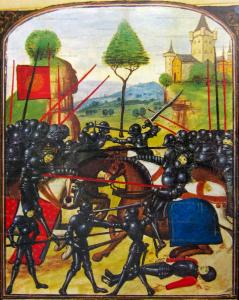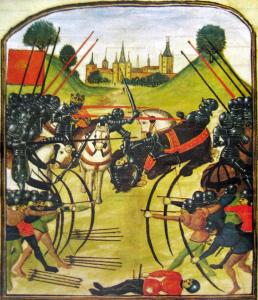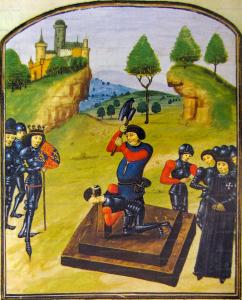Archaeologia Volume 21 Section III
Archaeologia Volume 21 Section III is in Archaeologia Volume 21.
Account of King Edward the Fourth's Second Invasion of England, in 1471, drawn up hy one of his Followers; with the King's Letter to the Inhabitants of Bruges upon his success: translated from a French Manuscript in the Public Library at Ghent. Communicated by Edward Jerningham (age 45), Esq. F.S.A. in a Letter to Nicholas Carlisle, Esq. F.R.S. Secretary. Read 13th April, 1820.

Edward Jerningham: On 14 Jul 1774 he was born to William Jerningham of Cossey Park 6th Baronet and Frances Dillon. He a great x 3 grandson of King Charles II of England Scotland and Ireland. On 29 May 1822 Edward Jerningham died.

Bolton-Row, March 10, 1820.
Dear Sir
I beg leave to communicate, through your hands, to the Society of Antiquaries, a facsimile Copy of a curious Manuscript, preserved in the Public Library at Ghent.
he Manuscript appears to be an illuminated transcript of a Report, drawn up by one of the followers of King Edward the Fourth in his final expedition from Zeland, anno 1471, and forwarded to the Court of Charles the Bold Duke of Burgundy, through whose advice and aid the same had been principally planned and effected.
The Report is accompanied by a letter from Edward himself, dated the 29th of May, and addressed to the inhabitants of Bruges, informing them of the complete success with which his expedition to England had been crowned, and thanking them for their hospitable and generous entertainment of himself and friends whilst residing in exile in their city.
The Report is divided into four heads, or chapters.
Chapter I. relates the departure of Edward and his followers from Zeland; the tempestuous weather they experienced at sea; their landing in the river Humber; their march to York; the retreat of the Earl of Warwick into Coventry; the siege of that town by King Edward; and the junction he effected with his brother Clarence at Warwick; the raising the siege of Coventry, and Edward’s march to London, where he got possession of the Tower, and of the persons of Henry VI. and the Archbishop of York; the advance of the Earl of Warwick from Coventry, in the hope of surprising Edward during the Easter holydays in London; and finally the battle of Barnet, in which the Earl of Warwick was slain.
Chapter II. relates the news received by Edward, of the arrival in England of Queen Margaret with her son Prince Edward; the king’s immediate departure from London; the approach of the two hostile armies in the neighbourhood of Bath and Bristol; and, finally, the battle of Tewksbury, in which Prince Edward is stated to have fallen.
Chapter III. relates the beheading, at Tewksbury, of the Duke of Somerset, the Prior of St. John of Jerusalem, and of the other prisoners taken after the battle; the intelligence brought to the king of the insurrection of the Bastard of Fauconbergh in Kent; and the immediate march of the former towards London for the defence of that capital.
Chapter IV. relates the unsuccessful attack made by the Bastard of Fauconbergh upon London, previous to the king’s arrival; his subsequent retreat, and seizure of the town of Sandwich with the shipping; and finally, the submission of the Bastard of Fauconbergh, with all his followers, on the 26th of May. Three days after this event, this Report appears to have been drawn up and forwarded to the Low Countries, accompanied by the king’s letter dated the 29th before-mentioned; the Report closing with the most confident hope, that the submission of the Bastard of Fauconbergh, would be very shortly followed by a general pacification throughout the kingdom.
The Manuscript is on vellum, of a quarto size, and at the head of each of the four chapters is an highly finished illuminated Miniature.
Miniature 1, represents the battle of Barnet. The two armies, clad in armour, appear engaged in close combat, the Lancastrians bearing a large ed banner, with a border and rose embroidered in gold. Edward on a white charger, caparisoned with red cloth lined with blue, and sem£ with fleurs de lis; his vizor raised, and a gold crown on the top of his helmet; appears to have just pierced with a long red lance the breastplate of his antagonist, intended no doubt for the Earl of Warwick.
In front two esquires are engaged hand to hand with swords; the Lancastrian is attempting to thrust the point of his weapon through the bars of his opponent’s helmet, whilst another of Edward’s squires is pushing him off with his lance; in the back ground, the open country appears between two high ridges of rock; on the summit of the right bank is a large castellated building. (See Plate I.)

Miniature 2 represents the battle of Tewksbury. Edward appears conspicuous on a brown horse, in complete armour, bearing on his shield the royal arms of France and England, with a crown on his helmet, and charging at the head of his horse j in front of the Lancastrians, a young knight with light-coloured hair, appears just beaten to the ground, his head uncovered, and the uplifted sword of a knight, mounted on a white charger richly caparisoned, just ready to strike it off. This probably was intended to represent the death of Prince Edward, by the hands of the Duke of Gloucester or Clarence: in front, the archers appear mutually engaged; the Yorkists, seemingly, with a plentiful supply of arrows at their feet. In the back ground, a town is seen with several steeples and spires, situated between two mounds, or barrows, covered with tufts of trees. (Plate II.)

Miniature 3, represents King Edward standing in armour, his shield emblazoned, without his helmet, and a gold crown on his head, witnessing the execution of the prisoners taken at Tewksbury. The executioner (a remarkable large man) appears upon a platform of wood raised with two steps; his axe uplifted, ready to strike off the head of the Duke of Somerset, who is bending over a block, clad in armour, with long gilt spurs, without his helmet, and a white bandage over his eyes; the other prisoners stand close to the platform, with mournful countenances, their hands tied before. John Lonstrother, the Prior of Saint John of Jerusalem, stands foremost, dressed in a long black gown, with the white cross of his order (now Maltese) on his left breast. In the back ground is represented a distant view of the country, between two high banks; on the summit of that to the left, is a building with several steeples, surrounded by an embattled wall. (Plate III.)

Miniature 4, represents the attack made by Thomas Nevill, son to the Lord Thomas Fauconbergh, and commonly called the Bastard of Fauconbergh, upon London. The Bastard is represented himself on a white horse, his lance just broken to pieces by a knight, sallying out of one of the city gates, at the head of a troop of horse, and his men appear in consequence to be turning their horses round, and retreating. Scaling-ladders are placed against the walls, and men mounting with flaming torches in their hands; whilst a trumpeter posted over the city gate is blowing a blast. (Plate IV.)
The Manuscript and Miniatures have been copied from the original by Lady Bedingfield, who obtained a particular permission for the purpose, from the trustees of the Public Library at Ghent, and it is in her name I beg to offer this communication to the Society.
I have the honour to be, dear Sir,
Your obedient Servant,
Edward Jerningham
To Nicholas Carlisle, Esq. F. R. S. Secretary.